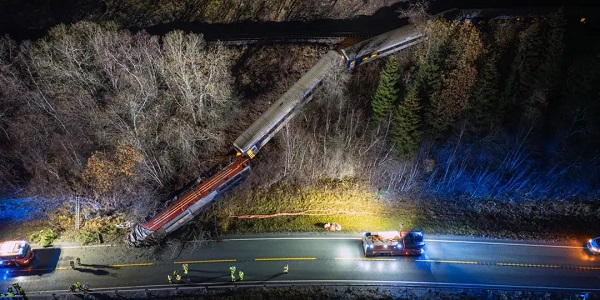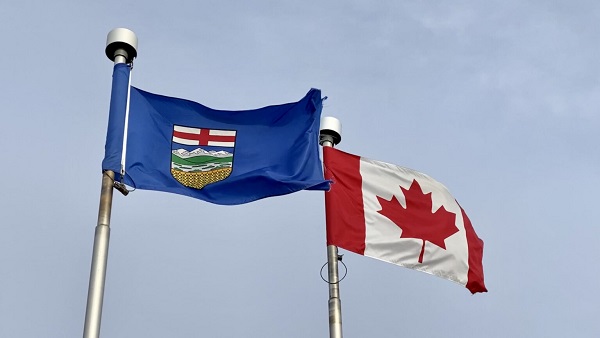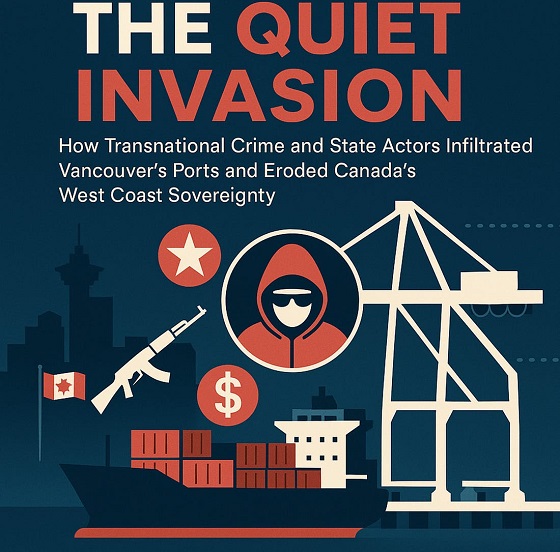Business
Norway’s Trainwreck – How Taxing Unrealized Gains Has Caused an Entrepreneurial Exodus

From hagaet the substack of Fredrik Haga, co-founder of Dune
Norway Shrugged
Recently, my story as a Norwegian entrepreneur facing an unrealized gains wealth tax bill many ties higher than my net income went viral, amassing over 100 million views on X. A few years ago I publicly called out that this tax is both impossible-to-pay and nonsensical, but no politician would listen. So I made the difficult decision to leave my home country. I still don’t know how I was supposed to pay the tax, but I recently found myself plastered on the “Wall of Shame” at the Socialist Left Party’s offices.
In this post, I’ll delve into why there’s an entrepreneurial exodus from Norway, how we got here, and what the future might hold.

Socialist Left leader and me on the “Wall of Shame” (Dagbladet)
Norway: A real life Atlas Shrugged
Ayn Rand’s 1957 novel Atlas Shrugged paints a vivid picture of a dystopian society where government overreach and socialist policies kill innovation and demonize entrepreneurs. In Rand’s world, working hard and taking risks is not celebrated, but looked at with suspicion. As the government tightens its grip, mandating how businesses should operate, the nation’s entrepreneurs begin to vanish and are nowhere to be found. People get poorer while the state keeps growing. Step by step the functioning of society starts to crumble. The trains first go off schedule, then start crashing and eventually stop going all together.
Present-day Norway mirrors this dystopia in unsettling ways. Taking risk with your own money, working hard and then making a profit is frowned upon. While politicians spending the people’s money on non-viable green projects, and delivering dysfunctional public services at high costs has the moral high ground. The government is spending 35 Billion NOK on offshore wind that industry experts think is financially unviable. This is about the same amount as the total wealth tax revenues. Norway spends 45% more than Sweden on health care per capita with approximately the same health outcomes. Norway has 2,5 times bigger share of the working population on sick leave than Denmark. Norway spends ~50% more than Finland on primary and secondary school with worse results.
With unshakeable ideological conviction, socialist politicians are rapidly undermining Norway’s wealth creation. They’re imposing taxes that explicitly disadvantage Norwegian business owners, and are often straight up impossible to pay. When confronted with the reality that you can’t pay taxes with money you don’t have—or that loss-making businesses can’t afford massive dividends just to cover owners’ wealth taxes—the response is vague moralism like “Those with the broadest shoulders must bear the heaviest burdens.” Any argument against any part of the system is by default invalid because there’s free health care…
Norway’s entrepreneurs are now indeed disappearing from society. In the past two years alone, a staggering 100 of Norway’s top 400 taxpayers, representing about 50% of that group’s wealth, have fled the country to protect their businesses.
Norwegian trains have for a long time been notoriously unreliable – even less reliable then in war time Ukraine! In chilling similarity to Atlas Shrugged there’ve been two train crashes, including one fatal, in the last month alone.

Tram crashing into a retail store in Oslo 29th of October 2024 (NRK)
The Unrealized Gains Wealth Tax: A Self-Inflicted Wound
Norway imposes a wealth tax that taxes unrealized gains at approximately 1% annually. Calculated on the full market value for publicly traded assets and the book value of private companies. On New Year’s Eve, whatever your net worth – including illiquid assets – is subject to this tax. It doesn’t matter if you’re running a loss-making startup with no cash flow, if your investments have tanked after the valuation date, or even if your company has gone bankrupt—you still owe the tax.
This creates a perverse scenario where business owners must extract dividends or sell shares every year just to cover their tax bill. With dividend and capital gains taxes at around 38%, you need to withdraw approximately 1.6 million NOK to pay a 1 million NOK wealth tax bill. You’re essentially paying taxes to pay taxes, draining capital from your business without any personal financial gain.
Moreover, the tax incentivizes Norwegians to take on excessive debt to reduce their taxable wealth, inflating housing prices and making the economy more fragile. While real estate and oil companies can mitigate this through debt financing, tech startups—often equity-financed and loss-making for years—are disproportionately harmed.
The Berlin Wall Exit Tax: Another Tax on Unrealized Gains
After witnessing a mass exodus of top taxpayers, the Norwegian government had a golden opportunity to reassess its policies. The wealth tax contributes less than 2% to the state budget; eliminating it and marginally increasing capital gains, corporate, or dividend taxes could have halted the entrepreneurial bleeding without affecting government budgets.
Instead, the government doubled down on what’s not working, introducing an exit tax on unrealized gains. Now, if you choose to move from Norway, you’re immediately liable to pay 38% of the total market value of your assets upon departure. It doesn’t matter if you have no liquidity, if your assets are high-risk and could plummet in value, or even if your company does fail after you leave—you still owe the tax. Previously, entrepreneurs could at least relocate if the wealth tax became too burdensome. Now, they’re incentivized to leave before they even start their businesses.
The government could have listened to the tornado of negative feedback and adjusted course, but instead, they doubled down on what’s not working. When the Berlin wall was created it was clear which side of the city had the better system… the one that didn’t have to build a wall to retain its citizens. Instead of trying to attract and retrain capital and talent by making Norway a better place for business the Norwegian government chose to build its very own Berlin Tax Wall with yet another tax on unrealized gains. Trapping not only entrepreneurs, but anyone with more than $270k of wealth wanting to move their life abroad for whatever reason…
The first 50 years: Well Managed Oil Wealth
Norway is one of the richest countries in the world. The government does not need to send their entrepreneurs abroad with non-sensical taxes. So you may ask yourself, “Well, how did we get here?”.
In fact, the oil wealth has been amazingly well managed by the politicians for almost half a century. In 1969, Norway struck oil—a discovery that could have led to the same resource curse that plagued other nations. Instead, Norwegian politicians made two genius decisions that benefited the entire population.
- Genius Move 1: Taxing Oil Profits at 80%Recognizing the need for foreign expertise but unwilling to let international corporations reap all the benefits, Norway taxed oil company profits at a staggering 80%. This bold move ensured that the wealth generated from the oil benefited the Norwegian people.
- Genius Move 2: Establishing the Sovereign Wealth FundIn the 1990s, Norwegian politicians understood that oil is a finite volatile resource and that it would be irresponsible to spend all the oil revenue on a running basis. In an act of rare political austerity and long term thinking they created the Oil Fund, to diversify and invest surplus revenues internationally. Furthermore the “Budgetary Rule” limited annual government spending from the fund to 3%, ensuring the fund in theory goes on forever.
For two decades, politicians across the spectrum adhered to this prudent financial management, displaying an impressive level of restraint and foresight rarely seen in politics.
How Oil Wealth Led to Socialist Ideology over Wealth Creation
But success bred complacency. In theory, everybody agrees that Norway needs new post-oil industries for the long term. In practice, the abundance of oil wealth has led to a detachment from the realities of how wealth and economic growth is created. While the Norwegian politicians impressively managed to restrain themselves for about half a century the current generation are now acting as if tax money grows on trees.
Ultimately that is the paradox that has caused the current situation: because the state has so much money, it is no longer at the mercy of businesses actually being created and staying in Norway. At least as long as the oil wealth lasts.
The 2025 Election: No Fundamental Solution in Sight
It seems likely there will be a new government after the 2025 elections, as the current government is seeing record-low support in the polls. Unfortunately, even seemingly business friendly opposition parties like the Conservative Party (Høyre) and the Liberals (Venstre) are not committed to abolishing the wealth tax entirely. They propose valuing companies zero for wealth tax purposes—a good step in the right direction, but not a fundamental solution to Norway’s ongoing crisis. Unfortunately The Progress Party (Fremskrittspartiet) is the only party that wants to remove the tax completely.
The wealth tax’s mere existence continues to create absurd incentives for excessive debt and over-investment in housing, detracting from more productive investments like stocks and startups. Moreover, the possibility of future governments reinstating the wealth tax for companies keeps the harmful uncertainty for businesses very much alive.
Many European countries have recognized the harm caused by taxing unrealized gains and abandoned it. Norway’s neighbor Sweden abolished its wealth tax in 2007. Since then they’ve seen its tech sector flourish. Spotify recently surpassed Norway’s state-owned oil company, Equinor, in market capitalization. In the last 15 years Norway has gone from having 7 to now only 2 of the Nordics top 30 most valuable companies.
Norway has produced four “unicorns”. Since then we the founders of Dune and Cognite have left due to the unreasonable taxes. Oda operates domestically in Norway. All founders have left the company and are wiped out. The last one Gelato is run by a swede that would likely move if they need to raise more money.
The Extra Long Journey to Post-Oil Wealth and Welfare
In Atlas Shrugged, the entrepreneurs refuse to return to society until the oppressive system collapses entirely. I sincerely hope Norway doesn’t have to endure such a downfall before entrepreneurs can return.
Fortunately Norway has a highly educated population and a lot of capital. With oil a high tech industry has been built in Norway before. What’s lacking is the political will to encourage entrepreneurship and big ambitions, not punish it.
Trust is built in millimeters and torn down in meters. In just a few years, the trust in Norway as a viable place to build and invest has been shattered. A whole generation of entrepreneurs has been lost.
The people of Norway currently enjoy and benefit from a host of generous welfare benefits. High income with short work days, free healthcare, free daycare, free education and beyond. For this to continue in the future Norway needs massive new post-oil industries. Due to the politicians’ series of unforced errors, the journey to get there will be extra long and painful. A definitive abolishment of all taxes on unrealized capital gains is the obvious first step.

Business
RFK Jr. says Hep B vaccine is linked to 1,135% higher autism rate

From LifeSiteNews
By Matt Lamb
They got rid of all the older children essentially and just had younger children who were too young to be diagnosed and they stratified that, stratified the data
The Centers for Disease Control and Prevention (CDC) found newborn babies who received the Hepatitis B vaccine had 1,135-percent higher autism rates than those who did not or received it later in life, Robert F. Kennedy Jr. told Tucker Carlson recently. However, the CDC practiced “trickery” in its studies on autism so as not to implicate vaccines, Kennedy said.
RFK Jr., who is the current Secretary of Health and Human Services, said the CDC buried the results by manipulating the data. Kennedy has pledged to find the causes of autism, with a particular focus on the role vaccines may play in the rise in rates in the past decades.
The Hepatitis B shot is required by nearly every state in the U.S. for children to attend school, day care, or both. The CDC recommends the jab for all babies at birth, regardless of whether their mother has Hep B, which is easily diagnosable and commonly spread through sexual activity, piercings, and tattoos.
“They kept the study secret and then they manipulated it through five different iterations to try to bury the link and we know how they did it – they got rid of all the older children essentially and just had younger children who were too young to be diagnosed and they stratified that, stratified the data,” Kennedy told Carlson for an episode of the commentator’s podcast. “And they did a lot of other tricks and all of those studies were the subject of those kind of that kind of trickery.”
But now, Kennedy said, the CDC will be conducting real and honest scientific research that follows the highest standards of evidence.
“We’re going to do real science,” Kennedy said. “We’re going to make the databases public for the first time.”
He said the CDC will be compiling records from variety of sources to allow researchers to do better studies on vaccines.
“We’re going to make this data available for independent scientists so everybody can look at it,” the HHS secretary said.
— Matt Lamb (@MattLamb22) July 1, 2025
Health and Human Services also said it has put out grant requests for scientists who want to study the issue further.
Kennedy reiterated that by September there will be some initial insights and further information will come within the next six months.
Carlson asked if the answers would “differ from status quo kind of thinking.”
“I think they will,” Kennedy said. He continued on to say that people “need to stop trusting the experts.”
“We were told at the beginning of COVID ‘don’t look at any data yourself, don’t do any investigation yourself, just trust the experts,”‘ he said.
In a democracy, Kennedy said, we have the “obligation” to “do our own research.”
“That’s the way it should be done,” Kennedy said.
He also reiterated that HHS will return to “gold standard science” and publish the results so everyone can review them.
Business
Elon Musk slams Trump’s ‘Big Beautiful Bill,’ calls for new political party

From LifeSiteNews
By Robert Jones
The Tesla CEO warned that Trump’s $5 trillion plan erases DOGE’s cost-cutting gains, while threatening to unseat lawmakers who vote for it.
Elon Musk has reignited his feud with President Donald Trump by denouncing his “Big Beautiful Bill” in a string of social media posts, warning that it would add $5 trillion to the national debt.
“I’m sorry, but I just can’t stand it anymore. This massive, outrageous, pork-filled Congressional spending bill is a disgusting abomination. Shame on those who voted for it: you know you did wrong. You know it,” Musk exclaimed in an X post last month.
I’m sorry, but I just can’t stand it anymore.
This massive, outrageous, pork-filled Congressional spending bill is a disgusting abomination.
Shame on those who voted for it: you know you did wrong. You know it.
— Elon Musk (@elonmusk) June 3, 2025
Musk renewed his criticism Monday after weeks of public silence, shaming lawmakers who support it while vowing to unseat Republicans who vote for it.
“They’ll lose their primary next year if it is the last thing I do on this Earth,” he posted on X, while adding that they “should hang their heads in shame.”
Every member of Congress who campaigned on reducing government spending and then immediately voted for the biggest debt increase in history should hang their head in shame!
And they will lose their primary next year if it is the last thing I do on this Earth.
— Elon Musk (@elonmusk) June 30, 2025
The Tesla and SpaceX CEO also threatened to publish images branding those lawmakers as “liars.”
Trump responded on Truth Social by accusing Musk of hypocrisy. “He may get more subsidy than any human being in history,” the president wrote. “Without subsidies, Elon would probably have to close up shop and head back home to South Africa… BIG MONEY TO BE SAVED!!!”
( @realDonaldTrump – Truth Social Post )
( Donald J. Trump – Jul 01, 2025, 12:44 AM ET )Elon Musk knew, long before he so strongly Endorsed me for President, that I was strongly against the EV Mandate. It is ridiculous, and was always a major part of my campaign. Electric cars… pic.twitter.com/VPadoTBoEt
— Donald J. Trump 🇺🇸 TRUTH POSTS (@TruthTrumpPosts) July 1, 2025
Musk responded by saying that even subsidies to his own companies should be cut.
Before and after the 2024 presidential election, Musk spoke out about government subsidies, including ones for electric vehicles, stating that Tesla would benefit if they were eliminated.
This latest exchange marks a new escalation in the long-running and often unpredictable relationship between the two figures. Musk contributed more than $250 million to Trump’s reelection campaign and was later appointed to lead the Department of Government Efficiency (DOGE), which oversaw the termination of more than 120,000 federal employees.
Musk has argued that Trump’s new bill wipes out DOGE’s savings and reveals a deeper structural problem. “We live in a one-party country – the PORKY PIG PARTY!!” he wrote, arguing that the legislation should be knows as the “DEBT SLAVERY bill” before calling for a new political party “that actually cares about the people.”
It is obvious with the insane spending of this bill, which increases the debt ceiling by a record FIVE TRILLION DOLLARS that we live in a one-party country – the PORKY PIG PARTY!!
Time for a new political party that actually cares about the people.
— Elon Musk (@elonmusk) June 30, 2025
In June, Musk deleted several inflammatory posts about the president, including one claiming that Trump was implicated in the Jeffrey Epstein files. He later acknowledged some of his comments “went too far.” Trump, in response, said the apology was “very nice.”
With the bill still under Senate review, the dispute underscores growing pressure on Trump from fiscal hardliners and tech-aligned conservatives – some of whom helped deliver his return to power. Cracks in the coalition may spell longer term problems for the Make America Great Again movement.
-

 Business10 hours ago
Business10 hours agoRFK Jr. says Hep B vaccine is linked to 1,135% higher autism rate
-

 Alberta2 days ago
Alberta2 days agoAlberta Independence Seekers Take First Step: Citizen Initiative Application Approved, Notice of Initiative Petition Issued
-

 Crime22 hours ago
Crime22 hours agoNational Health Care Fraud Takedown Results in 324 Defendants Charged in Connection with Over $14.6 Billion in Alleged Fraud
-

 Crime2 days ago
Crime2 days agoSuspected ambush leaves two firefighters dead in Idaho
-

 Alberta2 days ago
Alberta2 days agoWhy the West’s separatists could be just as big a threat as Quebec’s
-

 Health22 hours ago
Health22 hours agoRFK Jr. Unloads Disturbing Vaccine Secrets on Tucker—And Surprises Everyone on Trump
-

 Business2 days ago
Business2 days agoCanada Caves: Carney ditches digital services tax after criticism from Trump
-

 Business2 days ago
Business2 days agoMassive government child-care plan wreaking havoc across Ontario

